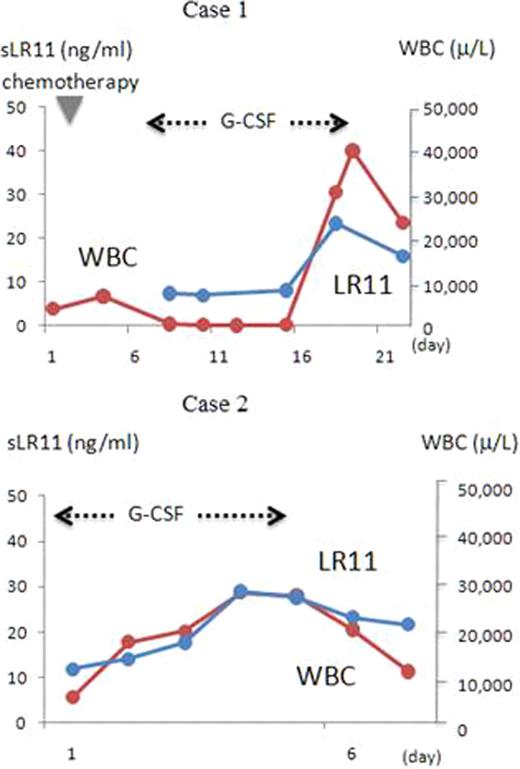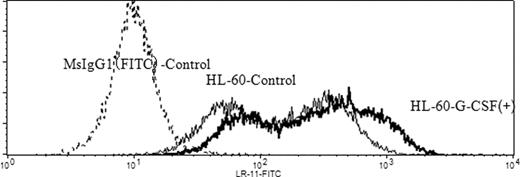Abstract
Abstract 3210
LR11 (also called SorLA or SORL1) is a type I membrane protein from which a large extracellular part, soluble LR11 (sLR11), is released by proteolytic shedding. LR11 plays a key role in the migration of undifferentiated vascular smooth muscle cells. Circulating sLR11 levels are a marker of accumulation of immature vascular cells, with immature human CD34+CD38− hematopoietic precursor cells having been shown to express high levels of LR11 mRNA. Recently, we showed that LR11 is specifically and highly expressed on the surface of acute leukemia cells in addition to normal leukocytes (unpublished data). Granulocyte-colony stimulating factor (G-CSF) stimulates hematopoietic stem cell (HSC) mobilization from the bone marrow (BM) to peripheral circulation and is commonly accepted as inducer of HSC mobilization in patients with hematological diseases. However, the mechanism underlying G-CSF-mediated release of HSCs from BM into peripheral circulation has not been fully elucidated. This study examined serum sLR11 levels during collection of HSCs and the role of sLR11 in migration and adhesion of HL-60 cells.
We analyzed serum samples of 15 patients who underwent the HSC collection procedure at Chiba University Hospital between 2010 and 2011. We initially examined the effects of G-CSF on the release of sLR11 from HL-60 cells into culture supernatants by an in vitro assay. We then measured expression of LR11 on HL-60 cells by flow cytometric analysis. sLR11 levels were measured in serum or culture supernatants by an ELISA method. A migration assay was performed using HL-60 cells incubated with or without G-CSF in transwell chambers with or without HUVECs, which were pre-incubated with or without TNF-a. An adhesion assay was performed using fibronectin-coated plates with or without HUVECs pre-incubated with or without TNF-a.
Circulating sLR11 levels were associated with time-related changes in the number of peripheral leukocytes during collection of HSCs following G-CSF treatment. Figure 1 shows the time course of two representative cases. In Case 1, a patient with malignant lymphoma, the number of leukocytes increased concurrently with an increase in serum sLR11 levels after chemotherapy, and then both decreased simultaneously. Case 2 was a patient with POEMS syndrome who was treated with G-CSF at the time of stem cell harvest. Similar to Case 1, following administration of G-CSF, the number of leukocytes increased concurrently with the increase in serum sLR11 levels, and then both decreased simultaneously. A close relationship was observed between serum sLR11 levels and leukocyte count, with a relative ratio of 0.63. We examined sLR11 in BM plasma by ELISA and showed that sLR11 was abundant in BM and was produced by BM hematological cells. sLR11 levels were increased significantly in the media containing HL-60 cells incubated for 12 h with 100 ng/ml G-CSF compared with those containing HL-60 cells incubated without G-CSF. Surface expression of LR11 on HL-60 cells increased with G-CSF treatment compared with controls (Figure 2), but not with SDF-1 treatment. In the migration assay, sLR11 stimulated the migration of HL-60 cells in a dose-dependent manner. Stimulation of migration activity by sLR11 was observed clearly in the presence of G-CSF with or without HUVECs. In the adhesion assay, sLR11 induced attachment of HL-60 cells to fibronectin-coated plates or HUVECs. This attachment increased when HL-60 cells were incubated with G-CSF. In a trans-endothelial migration assay, sLR11 also markedly increased the migration of HL-60 cells.
Clinical course of stem cell collection of two representative cases.
sLR11 is a novel chemotactic agent for HL-60 cells and induces strong enhancement of G-CSF-mediated migration and adhesion. LR11 may play a key role in G-CSF-mediated HSC mobilization by stimulating cell migration from BM into peripheral circulation.
No relevant conflicts of interest to declare.
Author notes
Asterisk with author names denotes non-ASH members.



